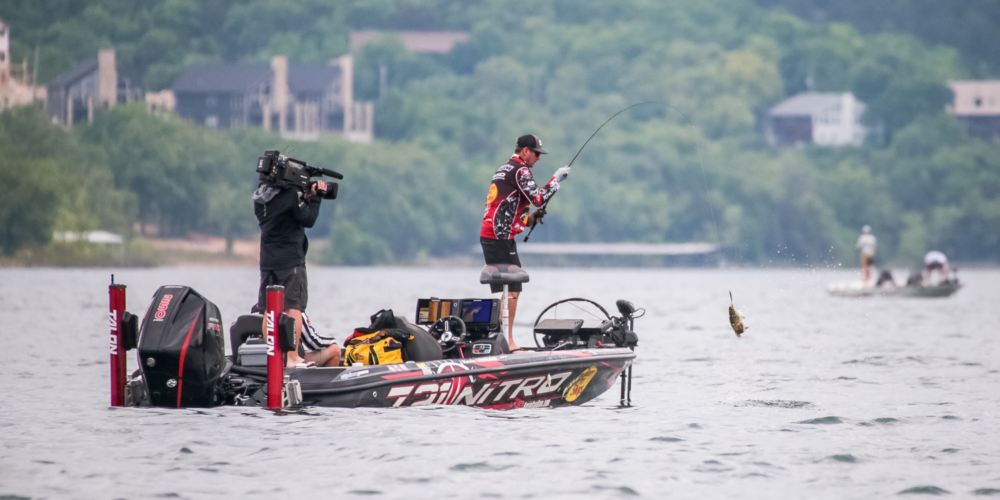KEVIN VANDAM: Drawdowns are the Catalyst for Fall Transition (Part 1 of 2)

It’s been a long, hot summer and fall is finally in the air. With that, the fall transition has begun on many lakes across the country. Days are getting shorter, water is cooling down, baitfish are beginning to move and the bass are breaking out of their summer doldrums.
This time of year, I’m often asked about the fall transition: how to tell when it’s happening and how to approach it. In some cases, the fall transition can be a gradual process. It might take a few cold fronts to really get things going; however, if you live near lakes that undergo drawdowns during the fall, consider yourself lucky.
When lake managers begin to drop a lake in the fall, it’s a definitive trigger that kicks the autumn transition into high gear for bass fishing.
Many reservoirs across the country go through a drawdown every year, usually during the late summer and fall. These drawdowns can range from just a few feet to 20 feet, depending on the part of the country. No matter how much it drops, the thing to remember is that bass in these reservoirs are conditioned to this yearly occurrence.
Think of it as a yearly low tide, and the bass recognize and respond to it just as soon as the water begins to be pulled out of the system. This may sound crazy, but in parts of the country where drawdowns are prolific – Texas, Oklahoma, the Ozarks and the Southeast – drawdowns bring excellent fishing conditions that can rival the peak of spring.
Some Key First Adjustments
The first thing I do when I get to a lake being drawn down is to adjust my Humminbird LakeMaster digital mapping with a setting called “Water Level Offset.” This might be one of the most overlooked tools in digital mapping. Simply put, it allows me to calibrate the contours to the current water levels. If the lake is down 3 feet, with one adjustment, I can essentially pull all the contours down to reflect that 3-foot drop so I am now looking at a true representation of the new water level.
If a lake is falling hard, I’ll check the lake level each day and adjust day-to-day if I need to.
I follow that by adjusting my “Shallow Water Highlight” to 5 feet so that anything that is 5 feet or less is in red. These two steps now give me an accurate look at the “new” lake after it has been pulled down. This is not only a tremendous advantage in finding fish during drawdown, it’s also a huge safety measure in navigating an unfamiliar, dewatered lake.
Increased Current = Increased Opportunity
The minute a drawdown begins, it usually means increased current in the system. Impoundments that don’t have much current during the dog days of summer, when they’re at full pool, begin to get a little flow, and this is what sparks the fall transition. This brings new life to main lake points, humps, shoals, roadbeds and any other features that pinch down or stick out into the main lake.
These are the kinds of places bass will school on baitfish being “pulled” through these areas. Even the slightest touch of current can kick this chain reaction into high gear and get the schooling bite going.
After checking a few main lake features for feeding activity, I’ll then check places that have vast shallow flats, either on the main lake or in the backs of major tributaries. When water is at full pool, bass have a lot of cover options up shallow. But as that water falls, their shallow cover begins to dry up, literally, and they are forced to move out to more isolated pieces of cover or subtle channel edges.
This is particularly true on flats where just a 10-inch drop in water can impact a large area. In short, less water congregates the fish on fewer targets making them much more predictable.
In grass lakes like Guntersville or those in Texas, the grass will be left matted up with dropping water, revealing small ditches, depressions and seams within the flats. These inconspicuous places are absolute money in grass lakes. Which reminds me, one of the big bonuses of fishing lakes while they are being drawn down is finding any of these subtle features and marking them for future reference. A small ditch, slight depression, discreet gravel bar, big stump, large rock, brush top – these are all things that can pay huge dividends when the water returns in the spring as well.
In part 2 I will break down some of the specific tactics I use in fall drawdowns.